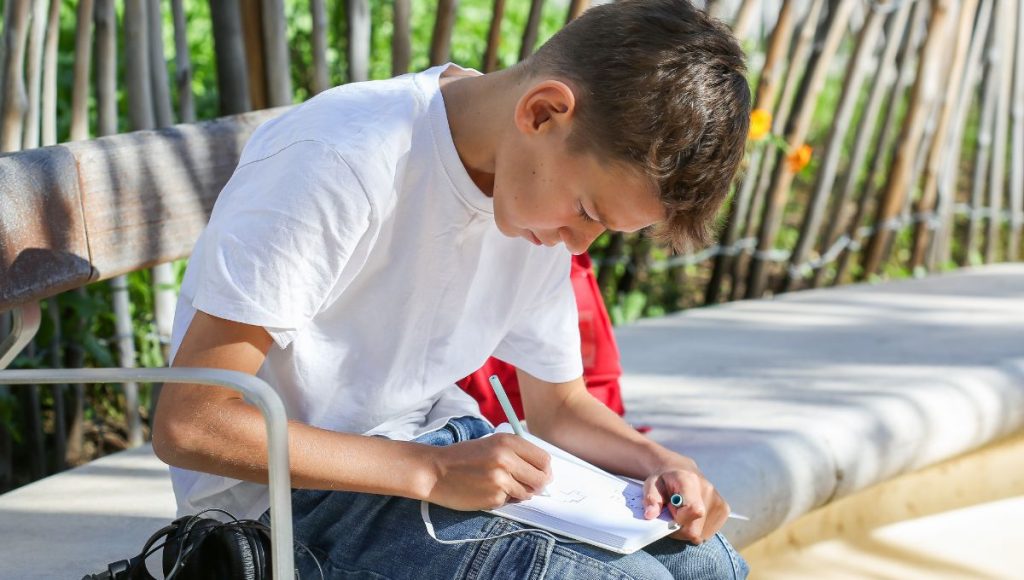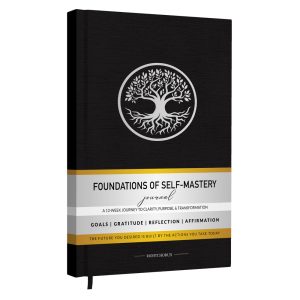High school is a whirlwind—fast-paced classes, social scene dynamics, and looming questions about the future.
That’s exactly why journaling is such a powerful tool right now. If you’re searching for impactful journal ideas for high school students, you’re in the right place.
When done consistently, journaling can offer clarity, confidence, and calm in the chaos of teen life.
In this post, we’ll explore creative, meaningful ways to use journaling for emotional wellness, identity discovery, and mindfulness.
You’ll also discover how tools like the Foundations of Self-Discovery Mastery Journal can support teens through every step of this inner journey.
Foundations of Self Discovery & Mastery Journal: A 13-Week Personal Development Journal System
$29.95
The Foundations of Self Discovery…
Table of Contents
Inspiring Journal Ideas for High School Students
The high school years are packed with intense emotions, tough decisions, and unforgettable growth.
That’s why curated journal ideas for high school students work best when they offer both structure and creativity.
Let’s dive into prompts that help teens reflect on their daily experiences while nurturing a calm, positive mindset.
Gratitude Prompts for Positivity
Gratitude journaling trains the brain to focus on what’s going well—even on harder days. These simple prompts keep high schoolers grounded in the present:
- Write down three things you’re thankful for today and explain why.
- Who supported you this week and how did it impact you?
- Describe a simple moment of joy you experienced today at school.
- What’s one thing about school you enjoy more than you admit?
These quick reflections can rewire teens’ mindset toward appreciation, which studies show improves both sleep and resilience.
Overcoming Academic Stress
Academic pressure can feel overwhelming, especially during exam season. Journaling can become a private outlet to process school stress and increase emotional regulation.
- What subject challenges you most right now? Why might that be?
- Describe a time you pushed through doubt and succeeded. What helped you?
- What’s something you’re proud of accomplishing this semester?
- If school stress had a voice, what would it say—and what would you say back?
The Foundations of Self-Discovery Mastery Journal offers structured daily prompts like these to help teens recalibrate and reframe academic overwhelm.
With its six-part daily framework, students are guided through both reflection and action so they can meet daily challenges with inner strength.
Foundations of Self Discovery & Mastery Journal: A 13-Week Personal Development Journal System
$29.95
The Foundations of Self Discovery…
Self-Discovery Journal Ideas for High School Students

High school is the ideal time to begin asking deeper questions: Who am I becoming? What do I value?
These journal exercises help teens explore their identity and visualize a future that feels authentic and aligned to their goals.
Identity and Values Exploration
Understanding personal values is crucial for decision-making and self-confidence. These prompts encourage thoughtful reflection:
- Who are your heroes or role models? What traits do you admire?
- What three words describe you best—and why?
- Think of a moment you felt proud of your choices. What values guided you?
- What’s a cause or theme you strongly believe in?
Exploring values early on builds a stronger moral compass and helps teens handle peer pressure effectively.
Visualizing Your Future Self
Imagining the future helps teens set meaningful goals while sparking motivation. Try these prompts:
- What does a typical day look like in your dream life, five years from today?
- If nothing could stop you, what would you pursue right now?
- What college major, hobby, or creative path excites you most—and why?
- If you could start a business or project today, what would it be?
The Foundations of Self-Discovery Mastery Journal includes a “Letter to My Future Self” and other future-visualization prompts to support teens as they dream of what’s ahead.
It gently encourages reflection on goals, progress, and identity development.
Foundations of Self Discovery & Mastery Journal: A 13-Week Personal Development Journal System
$29.95
The Foundations of Self Discovery…
Mindfulness and Emotional Wellness in Journaling
Adolescence comes with amplified emotions, hormonal shifts, and sensory overload.
Mindful journaling helps teenagers pause, reflect, and reconnect with their emotional center.
Here’s how this style of journaling can nurture balance and wellbeing.
Daily Check-In Practice
Daily emotional awareness strengthens emotional intelligence. These are perfect to include in a nightly journaling ritual:
- How are you feeling mentally, emotionally, and physically right now?
- Rate your stress level 1–10 and describe what’s contributing to it.
- Name the top three emotions you felt today. What triggered them?
- How did you take care of your mental or emotional health today?
Simple check-ins reduce emotional bottling, which contributes to improved communication skills over time.
Breathing Space for Big Emotions
When stress hits hard, journaling can offer soothing relief. Use these prompts to release and regulate:
- Write about a moment today that overwhelmed you. How did it affect you?
- If your emotions could speak, what would they want you to know?
- What self-care actions helped you today—or what do you wish you’d done?
- List three healthy things you can do to comfort yourself in a tough moment.
The Foundations of Self-Discovery Mastery Journal builds these practices into its morning and evening routine.
Using bite-sized prompts, mindfulness gets folded into everyday life, helping teens feel more centered and self-aware.
Foundations of Self Discovery & Mastery Journal: A 13-Week Personal Development Journal System
$29.95
The Foundations of Self Discovery…
Creative Expression Journal Ideas for Teens

Creativity can be deeply therapeutic. It unlocks emotional truths, relieves stress, and promotes deeper insights.
Journal pages can become artistic spaces where teens experiment, play, and let their minds wander freely.
Creative Writing Prompts
Short fictional or imaginative journal entries push personal boundaries and reduce journaling monotony:
- Imagine your life as a movie. What’s the title, soundtrack, and plot?
- If your thoughts were a landscape, what would it look like?
- Build a story around a stranger you passed today. What’s their secret life?
- Write a letter from your future self to you now. What advice do they have?
Creative writing is a powerful way for teens to explore identity in indirect, yet meaningful ways.
Art and Doodle Journaling
Drawing helps with emotional processing in ways words can’t always reach. Try:
- Sketch your favorite memory from the past month.
- Create a visual representation of your current mood.
- Design a magazine collage of your dream life (aka vision board page).
- Doodle lyrics, quotes, or affirmations that speak to your current mood.
Encouraging visual journaling complements the structured flow of the Foundations of Self-Discovery Mastery Journal, which includes ample blank space, cross-referenced notes pages, and visual goal-planning tools.
Foundations of Self Discovery & Mastery Journal: A 13-Week Personal Development Journal System
$29.95
The Foundations of Self Discovery…
Goal Setting and Growth Tracking Through Journals
Goal journaling transforms dreamers into doers. For teens, the right goal-tracking format can provide purpose, accountability, and motivation. It helps connect their daily actions to larger visions.
Academic and Personal Goals
Setting small, achievable goals builds self-confidence and executive functioning. Start with:
- What’s one assignment or class you want to improve in this week?
- What’s a personal goal unrelated to school you’re working on?
- Which habit would make your mornings less stressful?
- What reward will you give yourself after reaching a small milestone?
Linking effort to outcome helps young adults see the direct rewards of persistence.
Self-Assessment Check-Ins
Tracking personal development deepens self-awareness. Rely on prompts like these:
- What went well this week, and what pushed your limits?
- Name one thing you learned outside the classroom this week.
- What did you avoid that needs your attention—and why?
- Reflect on how your mindset has shifted in the last month.
The Foundations of Self-Discovery Mastery Journal supports structured reflection through its weekly recap sections, progress logs, and “Tomorrow’s Next Step” feature that boosts motivation and builds emotional endurance.
Foundations of Self Discovery & Mastery Journal: A 13-Week Personal Development Journal System
$29.95
The Foundations of Self Discovery…
Building a Journaling Habit That Sticks

Consistency is where transformation happens—but forming a new habit can be tough.
These simple strategies are designed to make journaling feel approachable, personal, and sustainable for busy high school students.
Creating a Journaling Space and Ritual
Environmental cues can trigger productive habits. Encourage students to:
- Choose a consistent time to journal—morning, before bed, or after lunch.
- Pick a quiet, cozy space that feels safe and inspiring.
- Use pens, stickers, or accessories that bring joy to the process.
- Pair journaling with another habit—like tea, music, or breathing exercises.
Routine makes journaling no longer a chore but a daily gift to oneself.
Making It Personal and Honest
Authenticity is what gives journaling its power. A teen’s journal should feel uniquely theirs:
- Remind yourself: No one ever needs to read this but you.
- Write in whatever form feels right—lists, doodles, poems, or affirmations.
- Don’t wait for perfect words—capture truth in the moment.
- Allow your entries to be raw, honest, and imperfect.
The Foundations of Self-Discovery Mastery Journal nurtures consistency through short, repeatable daily formats.
Teens can complete a spread in under 10 minutes and still walk away with valuable insights.
Foundations of Self Discovery & Mastery Journal: A 13-Week Personal Development Journal System
$29.95
The Foundations of Self Discovery…
Empowering Peer Connections Through Journaling
Journaling doesn’t have to be solitary. With the right approach, it can build trust, promote empathy, and deepen friendships among high schoolers navigating similar struggles.
Journal Sharing in Trusted Circles
Sometimes, teens benefit from processing experience with safe peers:
- Consider creating a “journal club” where friends reflect on shared prompts.
- Trade letters to future selves and talk about your insights.
- Share anonymous entries with a group to offer mutual support.
- Respond to the same prompt, then discuss different interpretations.
Intentional conversations can validate different perspectives and encourage vulnerability.
Journaling as a Bridge for Mentorship
Journaling can support parent-teen or teacher-student conversations:
- Discuss entries together during check-ins or after major transitions.
- Use journaling as a bridge for tough conversations.
- Encourage older siblings or mentors to share journaling wins.
- Create a shared family or classroom gratitude journal.
When modeled openly, journaling becomes a tool not just of self-awareness—but of connection, accountability, and care.
Conclusion
Journaling has the power to help teens manage emotions, clarify goals, and discover who they truly are.
These flexible journal ideas for high school students are stepping stones toward stronger emotional intelligence, increased mindfulness, and more resilient self-esteem.
Whether used in solitude or connection, journaling nurtures growth where it matters most: within.
For teens ready to explore further, the Foundations of Self-Discovery Mastery Journal is an exceptionally supportive companion.
With built-in prompts, check-ins, affirmations, and creative spaces, it builds confidence and self-awareness from day one.
Start small, write honestly, and return daily—your future self will thank you.
Frequently Asked Questions
Begin with gratitude lists, emotion check-ins, or light prompts like “Describe your perfect weekend” or “Write to your future self.” These ideas make the practice fun and approachable. Structure and creativity make all the difference, especially for first-time journalers.
Creating a routine is key—morning or evening. Use short, structured formats like in the Foundations of Self-Discovery Mastery Journal that only take 5-10 minutes. Pair journaling with daily activities like drinking tea or listening to music.
It enhances self-awareness, reduces anxiety, and creates an emotional outlet. Writing builds emotional regulation and helps teens gain perspective during high-stress times like exams and transitions.
Yes! The Foundations of Self-Discovery Mastery Journal was designed for teenagers and young adults. It features daily guided prompts, creative explorations, and self-check-ins that promote reflection and emotional development.
They can begin with how they feel, one word at a time. Or use guided prompts like those in the Foundations of Self-Discovery Mastery Journal to get started. Sometimes doodling or writing lists can unblock the flow.
Putting thoughts on paper relieves mental pressure and improves focus. Journaling allows teens to break big goals into small, actionable steps and gain emotional insight into academic challenges.
While both formats are valid, writing by hand has been linked to improved emotional processing and memory. Journals like the Foundations of Self-Discovery Mastery Journal also foster tactile mindfulness, making the experience more engaging.
Either morning for intention-setting or evening for reflection. Teens can also journal during lunch breaks or downtime between classes. The key is consistency and choosing what works best with their personal schedule.
Absolutely. By tracking successes, exploring identity, and expressing emotions, teens gain clarity and pride in who they are becoming. Over time, this quiet practice can result in powerful self-assurance.
Yes! In fact, combining art and words helps engage both brain hemispheres, supporting creativity and wellbeing. The Foundations of Self-Discovery Mastery Journal includes free space and creative sections to encourage visual exploration.







